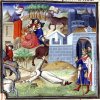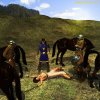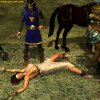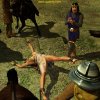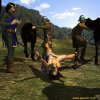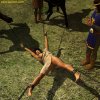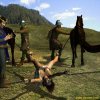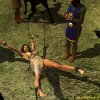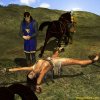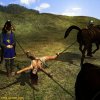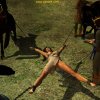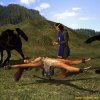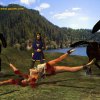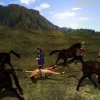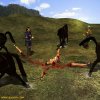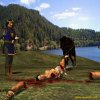Anne Askew tortured on the rack and burned at the stake
A.Askew preaching:
A.Askew tortured:
A.Askew burned:
ANNE ASKEW (1521-1546) was the second daughter of Sir William Askew, or Ayscough, knight, who is generally stated to be of Kelsey in Lincolnshire. But according to family and local tradition she was born at Stallingborough, near Grimsby, where the site of her father's house is still pointed out.1 The Askews were an old Lincolnshire family, and the consciousness of this fact may have had something to do with the formation of Anne's character. She was highly educated and much devoted to biblical study. When she stayed at Lincoln she was seen daily in the cathedral reading the Bible, and engaging the clergy in discussions on the meaning of particular texts. According to her own account she was superior to them all in argument, and those who wished to answer her commonly retired without a word.
At a time when she was probably still a girl a marriage was arranged by her parents for her elder sister, who was to be the wife of one Thomas Kyme of Kelsey. It was one of those feudal bargains which were of constant occurrence in the domestic life of those days. But the intended bride died before it was fulfilled, and her father, 'to save the money,' as we are expressly told, caused Anne to supply her place against her own will. She accordingly married Kyme, and had two children by him. But having, as it is said, offended the priests, her husband put her out of his house, on which she, for her part, was glad to leave him, and was supposed to have sought a divorce. Whether it was with this view that she came to London does not appear; but in March 1545 she underwent some examinations for heresy, of which she herself has left us an account, first at Sadler's Hall2 by one Christopher Dare, then before the lord mayor of London, who committed her to the Counter,3 and afterwards before Bishop Bonner and a number of other divines. It is unfortunate that we have no other record of these proceedings than her own,4 which though honest was undoubtedly one-sided, and is not likely to have been improved in the direction of impartiality by having been first edited by John Bale, afterwards bishop of Ossory, during his exile in Germany.
The subject on which she lay under suspicion of heresy was the sacrament. The severe Act of the Six Articles, passed some years before, had produced such a crop of ecclesiastical prosecutions that parliament had been already obliged to restrict its operation by another statute, and Henry VIII himself at the end of this very year thought it well to deliver an exhortation to parliament on the subject of christian charity. In such a state of matters Anne Askew had little chance of mercy. It is, however, tolerably clear, notwithstanding the gloss which Bale, and Fox after him, endeavoured to put upon it, that one man who sincerely tried to befriend her was the much-abused Bishop Bonner. He did his utmost to conquer her distrust and get her to talk with him familiarly, promising that no advantage should be taken of unwary words; and he actually succeeded in extracting from her a perfectly orthodox confession (according to the standard then acknowledged), with which he sought to protect her from further molestation. But when it was read over to her, and she was asked to sign, although she had acknowledged every word of it before, instead of her simple signature she added, 'I, Anne Askew, do believe all manner of things contained in the faith of the Catholic Church, and not otherwise.' The bishop was quite disconcerted. In Anne's own words, 'he flung into his chamber in a great fury.' He had told her that she might thank others, and not herself, for the favour he had shown her, as she was so well connected. Now she seemed anxious to undo all his efforts on her behalf. Dr. Weston, however (afterwards Queen Mary's dean of Westminster), contrived at this point to save her from her own indiscretion, representing to the bishop that she had not taken sufficient notice of the reference actually made to the church in the written form of the confession, and thought she was supplying an omission. The bishop was accordingly persuaded to come out again, and after some further explanations Anne was at length liberated upon sureties for her forthcoming whenever she should be further called in question. She had still to appear before the lord mayor, and did so on 13 June following, when she and two other persons, one being of her own sex, were arraigned under the act as sacramentaries; but no witnesses appeared against her or either of the others, except one against the man, and they were all three acquitted and set at liberty.
The accusers of Anne had for the time been put to silence, but unfortunately within a year new grounds of complaint were urged, and she was examined a second time before the council at Greenwich. Her opinions meanwhile seem to have been growing more decidedly heretical, and her old assurance in the face of learned disputants was stronger than ever. She was first asked some questions about her husband, and refused to reply except before the king himself. She was then asked her opinion of the sacrament, and, being admonished to speak directly to the point, said she would not sing a new song of the Lord in a strange land. Bishop Gardiner told her she spoke in parables. She replied that it was best for him, for if she showed him the open truth he would not accept it. He then told her that she was a parrot, and she declared herself ready to suffer not only rebuke but everything else at his hands. She had an answer ready for each of the council that examined her. Indeed, she sometimes seemed to be examining them, for she asked the lord chancellor himself how long he would halt on both sides.
Nevertheless, she was more closely questioned this time than she had been the year before. She was five hours before the council at Greenwich, and was examined again on the following day, being meantime conveyed to Lady Garnish.5 On the following Sunday she was very ill and desired to speak with Latimer, but was not allowed, let in the extremity of her illness she was sent to Newgate in such pain as she had never suffered in her life. But worse awaited her. On Tuesday following she was conveyed from Newgate to the sign of the Crown, where Sir Richard Rich endeavoured to persuade her to abandon her heresy. Dr. Shaxton, also, late bishop of Salisbury, urged her to make a recantation, as he had just lately done himself, but all to no purpose. Rich accordingly sent her to the Tower, where a new set of inquiries were addressed to her, for it seems some members of the council suspected that she received secret encouragement from persons of great influence. She denied, however, that she knew any man or woman of her sect, and explained that during her last year's imprisonment in the Counter she had been maintained by the efforts of her maid, who 'made moan' for her to the prentices in the street, and collected money from them. She did not know the name of any one who had given her money, but acknowledged that a man in a blue coat had given her ten shillings, and said it was from my lady Hertford. More than this even the rack could not get from her, which by her own statement afterwards (if we may trust a narrative which could scarcely in such a case have been actually penned by herself) was applied by Lord Chancellor Wriothesley himself and Sir Richard Rich, turning the screws with their own hands. Yet even after being released from this torture she 'sat two long hours reasoning with my lord chancellor upon the bare floor,' but could not be induced to change her opinion.
So far we have followed the account given as that of the sufferer herself. But it should be noticed that on 18 June 1546 she was arraigned for heresy at the Guildhall along with Dr. Shaxton and two others, all of whom confessed the indictment, and were sentenced to the fire. Dr. Shaxton and one of the others recanted next day, and it was either that day or a few days later that Anne Askew was racked in the Tower. On 16 July she and three others guilty of the same heresy were brought to the stake in Smithfield, she being so weak from the torture she had already undergone that she had to be carried in a chair. She was tied to the stake by a chain round the waist which supported her body. On a bench under St. Bartholomew's Church sat Lord Chancellor Wriothesley, the Dukes of Norfolk and Bedford, the lord mayor, and others, to witness the shameful tragedy; and, to complete the matter, Dr. Shaxton, who had so recently recanted the same heresy, was appointed to preach to the victims. Anne still preserved her marvellous self-possession, and made passing comments on the preacher's words, confirming them where she agreed with him, and at other times saying 'There he misseth and speaketh without the book.' After the sermon the martyrs began to pray. The titled spectators on the bench were more discomposed, knowing that there was some gunpowder near the faggots, which they feared might send them flying about their ears. But the Earl of Bedford reassured them. The gunpowder was not under the faggots, but laid about the bodies of the victims to rid them the sooner of their pain. Finally Lord Chancellor Wriothesley sent Anne Askew letters with an assurance of the king's pardon if she would even now recant. She refused to look at them, saying she came not thither to deny her Master. A like refusal was made by the other sufferers. The lord mayor then cried out 'Fiat justitia!' and ordered the fire to be laid to the faggots. Soon afterwards all was over. Anne is said by Bale to have been twenty-five years old when she suffered. She must therefore have been born in the year 1521.












































